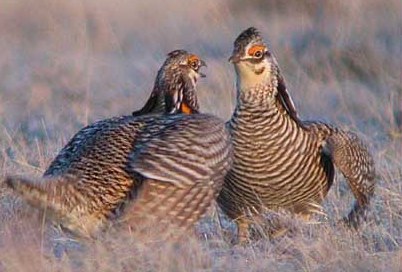State and federal wildlife officials are busy working to put together a long term lesser prairie chicken management plan. The proposed plan includes input from biologists in Colorado, New Mexico, Texas, Kansas and Oklahoma. If the plan gets the go-ahead nod from the US Fish and Wildlife Service then that means all states can get to work hunting for places to help wild chickens. But they will need a little help from Mother Nature.
Although drought has significant impacts on lesser prairie chicken populations, biologists are heartened by the fact that the lesser prairie-chicken has historically shown significant resiliency to periodic climatic events. When the birds were first proposed for listing in the 1990s, the region was experiencing a severe drought. In many areas, bird populations declined by more than 60 percent, but recovered to prior levels with a return to wetter years later in that decade.
Source: “For years, biologists have well-known that wildlife do not recognize state lines, which has presented prairie chicken management challenges for wildlife agencies,” says Bill Van Pelt, WAFWA Grassland Initiative Coordinator. “Often, population goals are set based on administrative boundaries. This plan not only sets biologically meaningful population objectives, it also allows for resources to be spent anywhere within the same habitat type, regardless of the state. This should give state wildlife agencies maximum management flexibility and, ideally, preclude the need to list it.”
The submittal of the range-wide plan comes at the same time the second annual statistically-valid, range-wide population estimate for the lesser prairie-chicken is being released. Analysis of the 2013 range-wide survey revealed population estimates of 17,616, down from the 34,440 birds estimated the previous year. This population decrease was predicted by biologists because of the persistent drought that has plagued the region in recent years.
Lesser prairie-chicken populations have fluctuated historically due to weather and habitat conditions. In fact, populations were so low during the droughts in the 1930s and 1950s biologists feared the species was almost extinct. However, when the rains returned, the populations rebounded.
WAFWA’s Grassland Initiative collaborated with the Lesser Prairie-chicken Interstate Working Group, which is composed of biologists from state fish and wildlife departments in Colorado, New Mexico, Texas, Kansas and Oklahoma, the Bureau of Land Management, and Western EcoSystems Technology, Inc. to conduct a large-scale, helicopter-based survey of lesser prairie-chicken leks across all five states. Leks are sites where the birds congregate every spring for breeding. These surveys occurred from March-May and encompassed more than 300,000 square miles.
The 2013 survey was funded by the five state fish and wildlife agencies and WAFWA with support from various partners, including oil and gas companies that support lesser prairie-chicken conservation, the Bureau of Land Management and a grant from the National Fish and Wildlife Foundation.
